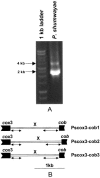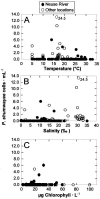Development of a cob-18S rRNA gene real-time PCR assay for quantifying Pfiesteria shumwayae in the natural environment
- PMID: 16269741
- PMCID: PMC1287735
- DOI: 10.1128/AEM.71.11.7053-7063.2005
Development of a cob-18S rRNA gene real-time PCR assay for quantifying Pfiesteria shumwayae in the natural environment
Abstract
Despite the fact that the heterotrophic dinoflagellate Pfiesteria shumwayae is an organism of high interest due to alleged toxicity, its abundance in natural environments is poorly understood. To address this inadequacy, a real-time quantitative PCR assay based on mitochondrial cytochrome b (cob) and 18S rRNA gene was developed and P. shumwayae abundance was investigated in several geographic locations. First, cob and its 5'-end region were isolated from a P. shumwayae culture, revealing three different copies, each consisting of an identical cob coding region and an unidentified region (X) of variable length and sequence. The unique sequences in cob and the X region were then used to develop a P. shumwayae-specific primer set. This primer set was used with reported P. shumwayae-specific 18S primers in parallel real-time PCRs to investigate P. shumwayae abundance from Maine to North Carolina along the U.S. east coast and along coasts in Chile, Hawaii, and China. Both genes generally gave similar results, indicating that this species was present, but at low abundance (mostly <10 cells x ml(-1)), in all the American coast locations investigated (with the exception of Long Island Sound, where which both genes gave negative results). Genetic variation was detected by use of both genes in most of the locations, and while cob consistently detected P. shumwayae or close genetic variants, some of the 18S PCR products were unrelated to P. shumwayae. We conclude that (i) the real-time PCR assay developed is useful for specific quantification of P. shumwayae, and (ii) P. shumwayae is distributed widely at the American coasts, but normally only as a minor component of plankton even in high-risk estuaries (Neuse River and the Chesapeake Bay).
Figures







Similar articles
-
Development of a real-time PCR probe for quantification of the heterotrophic dinoflagellate Cryptoperidiniopsis brodyi (Dinophyceae) in environmental samples.Appl Environ Microbiol. 2007 Apr;73(8):2552-60. doi: 10.1128/AEM.02389-06. Epub 2007 Feb 23. Appl Environ Microbiol. 2007. PMID: 17322326 Free PMC article.
-
Discovery of the toxic dinoflagellate Pfiesteria in northern European waters.Proc Biol Sci. 2002 Jan 22;269(1487):211-4. doi: 10.1098/rspb.2001.1852. Proc Biol Sci. 2002. PMID: 11798438 Free PMC article.
-
Development of a dinoflagellate-oriented PCR primer set leads to detection of picoplanktonic dinoflagellates from Long Island Sound.Appl Environ Microbiol. 2006 Aug;72(8):5626-30. doi: 10.1128/AEM.00586-06. Appl Environ Microbiol. 2006. PMID: 16885319 Free PMC article.
-
Detection of the Dinozoans Pfiesteria piscicida and P. shumwayae: a review of detection methods and geographic distribution.J Eukaryot Microbiol. 2005 Mar-Apr;52(2):83-9. doi: 10.1111/j.1550-7408.2005.05202007.x. J Eukaryot Microbiol. 2005. PMID: 15817112 Review.
-
Mitochondrial cob and cox1 genes and editing of the corresponding mRNAs in Dinophysis acuminata from Narragansett Bay, with special reference to the phylogenetic position of the genus Dinophysis.Appl Environ Microbiol. 2008 Mar;74(5):1546-54. doi: 10.1128/AEM.02103-07. Epub 2007 Dec 28. Appl Environ Microbiol. 2008. PMID: 18165361 Free PMC article.
Cited by
-
The quantitative real-time PCR applications in the monitoring of marine harmful algal bloom (HAB) species.Environ Sci Pollut Res Int. 2013 Oct;20(10):6851-62. doi: 10.1007/s11356-012-1377-z. Epub 2012 Dec 18. Environ Sci Pollut Res Int. 2013. PMID: 23247526 Free PMC article.
-
Spliced leader RNA trans-splicing discovered in copepods.Sci Rep. 2015 Dec 1;5:17411. doi: 10.1038/srep17411. Sci Rep. 2015. PMID: 26621068 Free PMC article.
-
Quantitative PCR method for enumeration of cells of cryptic species of the toxic marine dinoflagellate Ostreopsis spp. in coastal waters of Japan.PLoS One. 2013 Mar 13;8(3):e57627. doi: 10.1371/journal.pone.0057627. Print 2013. PLoS One. 2013. PMID: 23593102 Free PMC article.
-
Biology of the Marine Heterotrophic Dinoflagellate Oxyrrhis marina: Current Status and Future Directions.Microorganisms. 2013 Oct 21;1(1):33-57. doi: 10.3390/microorganisms1010033. Microorganisms. 2013. PMID: 27694763 Free PMC article. Review.
-
Serious overestimation in quantitative PCR by circular (supercoiled) plasmid standard: microalgal pcna as the model gene.PLoS One. 2010 Mar 5;5(3):e9545. doi: 10.1371/journal.pone.0009545. PLoS One. 2010. PMID: 20221433 Free PMC article.
References
-
- Akihito, I. A., T. Kobayashi, K. Ikeo, T. Imanishi, H. Ono, Y. Umehara, C. Hamamatsu, K. Sugiyama, Y. Ikeda, Y. Sakemoto, A. Fumihito, S. Ohno, and T. Gojobori. 2000. Evolutionary aspects of gobioid fishes based upon a phylogenetic analysis of mitochondrial cytochrome b genes. Gene 259:5-15. - PubMed
-
- Avise, J. C. 1986. Mitochondrial DNA and the evolutionary genetics of higher animals. Philos. Trans. R. Soc. London Biol. 312:235-242. - PubMed
-
- Baldauf, S. L., A. J. Roger, I. Wenk-Sifert, and W. F. Doolittle. 2000. A kingdom-level phylogeny of eukaryotes based on combined protein data. Science 290:972-974. - PubMed
-
- Berry, J. P., K. S. Reece, K. S. Rein, D. G. Baden, L. W. Haas, W. L. Ribeiro, J. D. Shields, R. V. Snyder, W. K. Vogelbein, and R. E. Gawley. 2002. Are Pfiesteria species toxicogenic? Evidence against production of ichthyotoxins by Pfiesteria shumwayae. Proc. Natl. Acad. Sci. USA 99:10970-10975. - PMC - PubMed
-
- Burkholder, J. M., and H. B. Glasgow, Jr. 1997. Pfiesteria piscicida and other Pfiesteria-like dinoflagellates: behavior, impacts, and environmental controls. Limnol. Oceanogr. 42:1052-1055.
Publication types
MeSH terms
Substances
Associated data
- Actions
- Actions
- Actions
LinkOut - more resources
Full Text Sources
Molecular Biology Databases

